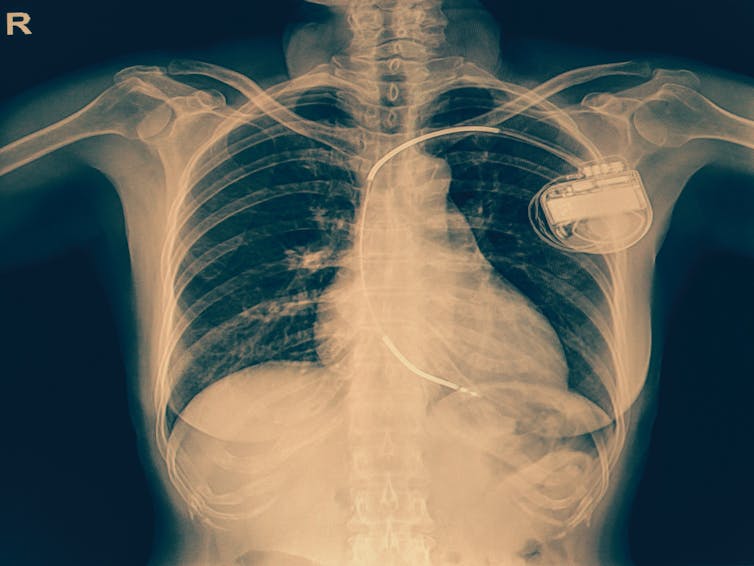Source: The Conversation (Au and NZ) – By Caleb Ferguson, Senior Research Fellow, Western Sydney Nursing & Midwifery Research Centre, Western Sydney Local Health District &, Western Sydney University
There are increasing concerns the new Apple iPhone 12 could interfere with implantable cardiac devices such as pacemakers, presenting a risk for people with heart problems.
The issue relates to a particular feature of the iPhone 12 — a new magnetic charging technology called MagSafe — which uses magnets to attach wireless charging accessories to the phone.
Patients with implantable cardiac devices are being warned keeping their iPhone 12 too close to their chest, such as in a shirt pocket or handbag, could cause temporary disruptions to their cardiac device’s functions.
So how does this happen, and what do you need to know if you’ve got both an implanted cardiac device and an iPhone 12?
First, some background
Pacemakers, and another type of implantable cardiac device called implantable cardioverter defibrillators, are both used widely in health care.Pacemakers have traditionally been used to regulate a person’s heartbeat, particularly if it’s slow.
Implantable cardioverter defibrillators regulate the heart’s rhythm in people who experience heart rhythm disorders, such as ventricular arrhythmias. These devices can also deliver defibrillation (a shock) to restore a normal heart rhythm in the event of a sudden, life-threatening arrhythmia.
Implantable cardioverter defibrillators have been shown to improve survival for people with heart rhythm problems, and they’re becoming more common in Australia.
Around 200,000 Australians have a pacemaker or defibrillator implanted. It’s also now common to have a dual-function implantable cardioverter defibrillator and pacemaker.
Read more: Apple’s iPhone 12 comes without a charger: a smart waste-reduction move, or clever cash grab?
So what’s going on?
MagSafe was developed with a view to removing the need for charging cables between the phone and the charger. Instead, a ring of magnets built around a charging coil inside the back of the iPhone connects the phone magnetically with various charging accessories.
Implantable cardiac devices work by sending electrical impulses to the heart. Magnetic and electrical fields are related — electrically charged particles that align in the same direction generate a magnetic field.
Most magnets are made from materials called alloys. Variations in the combination of alloys creates different types of magnets with different strengths. Ceramic magnets, such as those we use on the fridge, are not particularly strong, so won’t interfere with cardiac devices.
But the magnets inside the iPhone 12 and MagSafe accessories contain 100% recycled rare-earth elements. Rare-earth magnets are the strongest type of hard magnets on the market today — and strong enough to cause an interaction between the phone and the cardiac device.
Read more: In cases of cardiac arrest, time is everything. Community responders can save lives
Implantable defibrillators are designed to react with magnets
When clinicians need to deactivate implantable cardiac devices, they generally use magnets. Implantable cardioverter defibrillators, for example, may be deactivated for a range of reasons, including because it’s the patient’s preference, or when they’re nearing the end of their life.
Pacemakers and implantable cardioverter defibrillators have an inbuilt switch that reacts to externally applied magnetic fields. So clinicians can apply a clinical ring magnet to temporarily deactivate the device. We call this “magnet mode”.

It appears proximity to an iPhone 12 also causes “magnet mode” to kick in. Recently, a team of cardiologists tested the interaction between the iPhone 12 and an implantable cardioverter defibrillator. They noted immediate suspension of the implantable cardioverter defibrillator, which persisted as long as the iPhone was placed over the left side of the chest, in a shirt pocket.
When an implantable cardioverter defibrillator is in “magnet mode”, it’s reprogrammed to manufacturer settings, and the arrhythmia detection and treatment functions are deactivated or disabled. Temporary pacing modes are not affected, so the implantable cardioverter defibrillator can still increase heart rate if it’s slow.
Removing the magnet (the iPhone) should return the implantable cardioverter defibrillator to its previous program settings. But even a temporary disruption to this technology could potentially be dangerous.
We haven’t been able to find information describing any real-world cases of interference caused by the iPhone 12, and scientists are yet to test the effect of an iPhone 12 on a pacemaker.
But the evidence we have so far has prompted experts to draw attention to the issue.
Advice for people with implantable defibrillators and pacemakers
The Heart Foundation and the Australian and New Zealand Cardiac Device Advisory and Complication Committee have both warned iPhone 12 users with these implants to avoid placing the iPhone 12 in a top shirt pocket.
Apple has acknowledged the issue, recommending iPhone 12 users keep their iPhone and MagSafe accessories a safe distance away from their implantable cardiac devices. They specify 15cm apart, or more than 30cm apart if the phone is wirelessly charging.
Apple has also recommended patients consult their doctor and device manufacturer for device-specific recommendations.
Read more: Digital diagnosis: How your smartphone or wearable device could forecast illness
If you have an implantable cardioverter defibrillator or a pacemaker, avoid storing your iPhone 12 in the left-hand shirt pocket or in a handbag on your left arm. A pocket in your pants will be safer.
And it’s a good idea to speak with your health-care professional about magnetic sensitivity and your device during your next visit.
– ref. Got an implantable defibrillator or a pacemaker? Keep your iPhone 12 in your trouser pocket, not your shirt – https://theconversation.com/got-an-implantable-defibrillator-or-a-pacemaker-keep-your-iphone-12-in-your-trouser-pocket-not-your-shirt-154823







